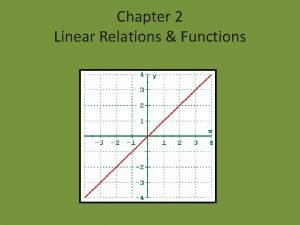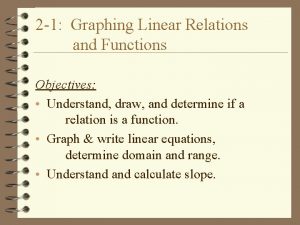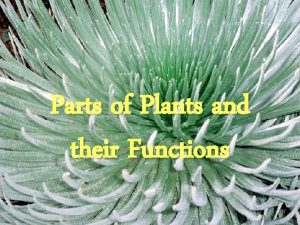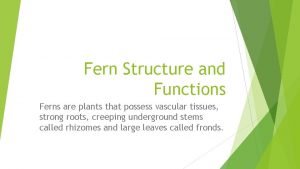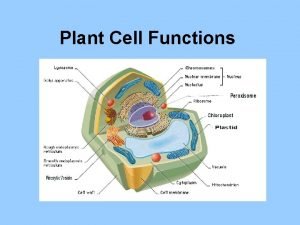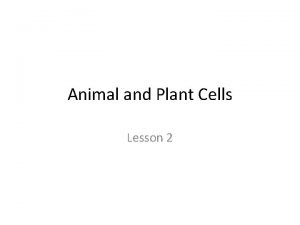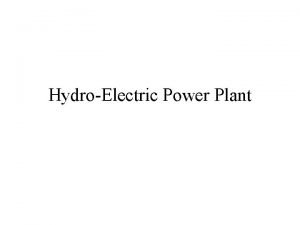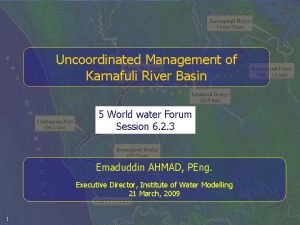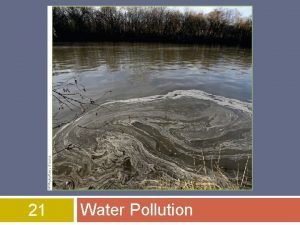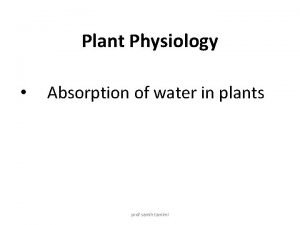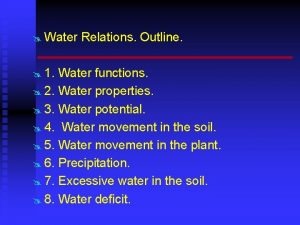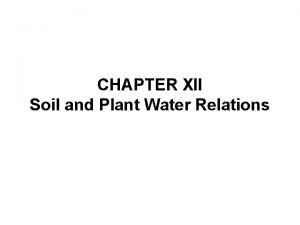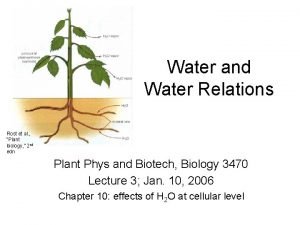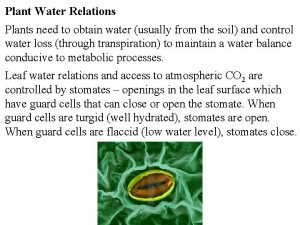PLANT WATER RELATIONS Water and its functions in








































































- Slides: 72

PLANT WATER RELATIONS Water and its functions in plant system: • major constituent of all living cells (70 to 90 % of cell contents) • All vital processes of the life carried out in Water (medium for many biochemical reactions, Inter conversion of carbohydrates and organic acids depend upon hydrolysis and condensation reactions) • Inorganic nutrients, photosynthates and hormones are transported in aqueous solution • soil plant atmosphere water continuum: Movement of water form soil solution to root, stem and then to atmosphere, A continuous movement from soil to atmosphere • Evaporation of water can control the temperature of leaf on canopy • Soil nutrients are available to plant roots only when dissolved in water

Organic constituents of plants such as carbohydrates, proteins, nucleic acids, enzymes etc. lose their physical and chemical properties in the absence of water • Water increases the rate of respiration, Seeds respire fast in the presence of water • Water is the source of hydrogen atom for the reduction of CO 2 in the reaction of photosynthesis • Water present in the vacuoles helps in maintaining the turgidity of the cells which helps in maintaining the form and structure • Water helps in translocation of solutes

Properties of water • Water as a chemical is a small molecule • low MW: 18, melting point : 0°C, boiling point : 100°C • Principle properties of water: dipolar nature and hydrogen bonding • Structure which has both positive and negative charges on the same surface area is called as Polar/bipolar/dipolar structure

• Water has high specific heat, heat of vaporization and heat of fusion • specific heat: Amount of energy required to raise the temperature of one gram of water by 1° C (resist temperature change) • latent heat of vaporization: Amount of energy required to change one gram of liquid water to water vapour (cooling effect) • latent heat of fusion: Amount of energy required to change one gram of liquid water to ice (frost control, sprinkling plants/crop to avoid freezing damage)

• Water shows very high adhesive and cohesive property. • cohesion and adhesion: are the "stickiness" that water molecules have for each other and for other substances • Attraction between the unlike molecules [water and other charged molecules] or ability of a substance to have intermolecular attraction between dissimilar particles is called adhesive property. • Ability of substance to have high intermolecular attraction between similar molecules is called cohesion property • Water has high cohesion since each water molecule can form four hydrogen bonds with neighboring molecules

Four additional properties of water based on adhesive and cohesive properties 1. high tensile strength: • Ability of group of water molecules to withstand high levels of tension or negative pressure without getting separated itself. • helps in bulk movement of water in plant system 2. high surface tension: • The tension of the surface film of a liquid caused by the attraction of the particles in the surface layer by the bulk of the liquid, which tends to minimize surface area 3. high capillary force: • Ability of liquid to raise to different levels in tubes of narrow diameter is called as capillary force.

4. Low viscosity: • Ability of liquid to flow from one region to other region due to cohesion and adhesive property of water is called as viscosity 5. high dielectric constant: • It is the ability of substance to neutralise the charges present on the surface of another substance • Due this property water is called as universal solvent • The dielectric constant tells us how well the solvent is able to separate ions. • For example: Coordination of water molecules around the anion and the cation greatly reduces the ion attraction in the salt.

Diffusion • The movement of particles or molecules or ions from a region of higher concentrations to a region of lower concentration due to random kinetic motion of the particles • The rate of diffusion of gases is faster than liquids or solutes • The diffusing particles have a certain pressure called as the diffusion pressure (the potential ability of molecules or ions of any substance to diffuse from an area of their higher concentration to that of their low concentration) which is directly proportional to the number or concentration of the diffusing particles. • Therefore the diffusion takes place always from a region of higher diffusion pressure to a region of lower diffusion pressure i. e. , along a diffusion pressure gradient

Factor which influences the diffusion are 1. Spatial factors; which includes a) Path length of diffusion b) Area through which diffusion is occurring c) Resistance against free diffusion 2. Higher temperature will increase the diffusion rate 3. Pressure 4. Molecular weight lighter molecules will diffuse faster than the heaver molecules

• The rate of diffusion increases if, a. the diffusion pressure gradient is steeper b. the temperature is increased c. the density of the differing particles is lesser d. the medium through which diffusion occurs is less concentrated

Significance of diffusion 1. It is an essential step in the exchange of gases during respiration and photosynthesis 2. During passive salt uptake, the ions are absorbed by diffusion 3. It is important in stomatal transpiration

Osmosis • The movement or diffusion of water molecules/solvent from a region of higher concentration to lower concentration through a semi permeable membrane • It is also referred as Osmotic diffusion • In case there are two solutions of different concentrations separated by the semi permeable membrane, the diffusion of solvent will take place from the less concentrated solution into the more concentrated solution till both the solutions attain equal concentration

• Osmotic pressure • As a result of the separation of two solutions by the semi permeable membrane, a pressure is developed in solutions due to the presence of dissolved solutes in it • This is called as osmotic pressure (OP) • OP is measured in terms of atmospheres and is directly proportional to the concentration of dissolved solutes in the solution • More concentrated solution has higher OP • The OP of a solution is always higher than its pure solvent • During osmosis, the movement of solvent molecules takes place from the solution whose osmotic pressure is lower i. e. , less concentrated or hypotonic into the solution whose osmotic pressure is higher i. e. , more concentrated or hypertonic • Osmotic diffusion of solvent molecules will not take place if the two solutions separated by the semi permeable membrane are of equal concentration having equal osmotic pressures (i. e. , they are isotonic)

• If a living plant cell is placed in water or hypotonic solution whose OP is lower than cell sap, water enters into the cell sap through osmosis and the process is called endosmosis • Due to the entry of water within the cell sap, a pressure is developed which press the protoplasm against the cell wall and the cell becomes turgid • This pressure is called as turgor pressure • Consequence of the turgor pressure is the wall pressure which is exerted by the elastic cell wall against the expanding protoplasm • At a given time, turgor pressure (TP) equals the wall pressure (WP) i. e. TP=WP.

• If the plant cell is placed in hypertonic solution (whose OP is higher than cell sap) the water comes out of the cell sap into the outer solution and the cell becomes flaccid • This process is known as exosmosis • During the exosmosis, the cell membrane will be separated from the cell wall and this condition is called as plasmolysis • In the case of isotonic solution, cell (or) tissue will remain as such as there is no movement of water molecules

Significance of osmosis in plants 1. Large quantities of water are absorbed by roots from the soil by osmosis 2. Cell to cell movement of water 3. Opening and closing of stomata depend upon the turgor pressure of guard cells 4. Due to osmosis, the turgidity of the cells and hence the shape or form of the organs is maintained 5. The resistance of plants to drought and frost increases with increase in osmotic pressure 6. Turgidity of the cells of the young seedling allows them to come out of the soil


• Water potential • Every component of a system possesses free energy capable of doing work under constant temperature conditions • For non electrolytes, free energy / mole is known as chemical potential • With reference to water, the chemical potential of water is called as water potential • The chemical potential is denoted by a Greek letter Psi, ψ • The water molecules possess free energy and the free energy of pure water is greater than the free energy of other solutions prepared in water • The difference between the free energy of water molecules in pure water and the free energy of water molecules in any other system is termed as water potential

• For pure water, the water potential is zero (the maximum value) • The presence of solute particles will reduce the free energy of water or decrease the water potential • Therefore it is expressed in negative value • The water potential of any solution is always less than zero and hence expressed in negative value • For cell, water potential is determined by three internal factors i. e. • ψ w : ψm + ψs + ψp • Where, ψm : is the matric potential • ψS : solute potential or osmotic potential • ψp : pressure potential or turgor potential

• Matric potential: It is the term used for the surface to which the water molecules are adsorbed • The matric potential is the component of water potential influenced by the presence of a matrix (for example soil particles with adsorbed water molecules) • In plant system, the matric potential is disregarded as it is not significant in osmosis • Therefore, ψw = ψs + ψp

• Solute potential: It is also known as osmotic potential • It can be defined as the amount by which the water potential is reduced as a result of the presence of solute • It has got a negative value • OR the decrease in chemical potential of pure water due to presence of solute in it

• Pressure potential: The hydrostatic pressure exerted by the protoplasm against the cell wall as a result of entry of water is called as turgor pressure • The potential created by such pressures is called pressure potential • The pressure potential is usually positive and operates in plants as wall pressure and turgor pressure • In a partially turgid cell, ψw: ψs + ψp (High water potential) • In a fully turgid cell, ψw: Zero (Highest water potential) • In a flaccid or plasmolyzed cell, ψw = ψs (Lowest water potential)

• • Water potential in a system can be decreased by; 1. Addition of water soluble solutes 2. Negative pressure /tension [in plant system i. e. , xylem] 3. Reduction in temperature Water potential in a system can be increased by; 1. Positive pressure 2. Increase in temperature

• ABSORPTION OF WATER • Soil water is the most important constituent of soil as it provides the medium for the absorption of nutrient elements and organic matter by the roots CATEGORIES OF WATER DEPENDING UPON THEIR AVAILABILITY 1. Gravitational water • Gravitational water is free water moving through soil by the force of gravity • It is largely found in the macropores of soil and very little gravitational water is available to plants as it drains rapidly down the water table in all except the most compact of soils

2. Capillary water • It refers to the bulk of water remaining in the soil after gravitational water has drained away • Capillary water is water held in the micropores of the soil, and is the water that composes the soil solution • Capillary water is held in the soil because the surface tension properties (cohesion and adhesion) of the soil micropores are stronger than the force of gravity • However, as the soil dries out, the pore size increases and gravity starts to turn capillary water into gravitational water and it moves down • Capillary water is the main water that is available to plants as it is trapped in the soil solution right next to the roots of the plant

3. Hygroscopic or imbibed water • Hygroscopic water forms as a very thin film surrounding soil particles and is generally not available to the plant • This type of soil water is bound so tightly to the soil by adhesion properties that very little of it can be taken up by plant roots • Since hygroscopic water is found on the soil particles and not in the pores, certain types of soils with few pores (clays for example) will contain a higher percentage of it


4. Runaway water • The major part of water that flows on the surface of the soil is called runaway water • Plants fail to avail this water 5. Chemically bound water • Some of the water molecules are chemically combined with soil minerals like iron, aluminium etc. • This is also not available to the plants

Field capacity or water holding capacity of the soil • After heavy rain fall or irrigation, some water is drained off along the slopes and a little amount of water is retained by the soil • This amount of water retained by the soil is called as field capacity or water holding capacity of the soil • OR Field capacity is the soil water content a few days after the soil has been thoroughly wetted, and downward movement of gravitational water has become very slow • Field capacity is affected by soil profiles, soil structure and temperature • Soil profile: A vertical section of the soil that depicts all of its horizons (a distinct layer of soil) • Soil structure: The arrangement of soil particles and their aggregate into certain defined patterns


Permanent wilting percentage or wilting coefficient • The percentage of soil water left after the plants growing in that soil has permanently wilted is called as permanent wiling percentage or the wilting coefficient OR • The amount of water a soil contains after plants are wilted beyond recovery is called the permanent wilting percentage • Wilting is the reduction in the volume of water in the plant cells sufficient enough to cause them to lose their turgor • The wilting may be visible in plant as drooping, rolling, folding of leaves or young stems • Wilting may occur for two reasons: 1. If the rate of transpiration exceeds the rate of absorption of water from the soil 2. If the soil is not having adequate amount of water for the survival of plants

Mechanism of water absorption • In higher plants, water is absorbed through root hairs that are in contact with soil water • Root hairs are tubular hair like prolongations of the cells of the epidermal layer (when epidermis bears root hairs, it is also known as piliferous layer) of the roots • The walls of root hairs are permeable and consist of pectic substances and cellulose which are strongly hydrophilic in nature • Root hairs contain vacuoles filled with cell sap • When roots elongate, the older root hairs die and new root hairs are developed so that they are in contact with fresh supplies of water in the soil

Kramer (1949) proposed that water is absorbed by two mechanisms 1. Active absorption of water • In this process the root cells play active role in the absorption of water and metabolic energy released through respiration is consumed • Active absorption may be of two kinds • (a) Osmotic absorption: Water is absorbed from the soil into the xylem of the roots according to osmotic gradient • (b) Non osmotic absorption: Water is absorbed against the osmotic gradient 2. Passive absorption of water • It is mainly due to transpiration; the root cells do not play active role and remain passive

1. Active absorption of water a. Active osmotic absorption of water • Atkins (1916) and Priestley (1922) postulated the active osmotic absorption of water • The first step in osmotic absorption of water is the imbibition of soil water by the hydrophilic cell walls of root hairs • Osmotic pressure (OP) of the cell sap of root hairs is usually higher than the OP of the soil water • Water from the cell walls enters into them through plasma membrane by osmotic diffusion • As a result, OP of root hairs now become lower, while their turgor pressure is increased (If solute concentration is high and water potential is low in the root cells, water can enter from soil to root cells through endosmosis. Mineral nutrients are absorbed actively by the root cells due to utilization of adenosine triphosphate (ATP). As a result, the concentration of ions (osmotica) in the xylem vessels is more in comparison to the soil water. A concentration gradient is established between the root and the soil water)

• Now, the cortical cells adjacent to root hairs have high OP in comparison to the root hairs • Therefore, water is drawn into the adjacent cortical cells from root hairs by osmotic diffusion • In the same way, by cell to cell osmotic diffusion water gradually reaches the inner most cortical cells and the endodermis

• Osmotic diffusion of water into endodermis takes place through special thin walled cells called passage cells because the other endodermal cells have casparian strips • Water from endodermal cells is drawn into the cells of pericycle by osmotic diffusion which now become turgid • In the last step, water is drawn into xylem from turgid pericycle cells (It is the absorption of minerals that utilize metabolic energy, but not water absorption. Hence, absorption of water is indirectly an active process in a plant's life)

b. Active non osmotic absorption of water • Proposed by Bennet Clark et al (1936), Thimann (1951) and Bogen and Prell (1953) • They observed that absorption of water sometimes takes place even when OP of soil water is high than OP of cell sap • They proposed that this type of absorption which is non osmotic and against the osmotic gradient requires the expenditure of metabolic energy probably through respiration • However, Kramer (1969) reported that active absorption of water has negligible importance in the water economy of almost all plants • Aquaporins (are proteins embedded in the cell membrane that regulate the flow of water) might also be associated with non osmotic absorption of water • However, it is said that, the evidences supporting active absorption of water are poor

Passive absorption of water • Passive absorption of water takes place when rate of transpiration is usually high • Rapid evaporation of water from the leaves during transpiration creates a tension in water in the xylem of the leaves • This tension is transmitted to water in xylem of roots through the xylem of stem and water rises upward to reach the transpiring surfaces • As a result, soil water enters into the cortical cells through root hairs to reach the xylem of roots to maintain the supply of water • The force of this entry of water is created in leaves due to rapid transpiration and hence, the root cells remain passive during this process

ASCENT OF SAP • Sap is a liquid containing water and dissolved mineral salts • The upward movement of water from the root system to the aerial parts of the plant through the xylem is known as ascent of sap • Xylem is the main water conducting tissue and the ascent of sap take place through the xylem • The ringing experiment of Malpighi proved that ascent of sap takes place through xylem • A ring of bark (all tissues outside the xylem) is removed from the stem and the plant is left as such for a few days • The leaves above the ringed part of the stem remain fresh and green • This shows that the ascent of sap occurs through xylem • Similarly, if a portion of xylem is removed by making a hole in the stem, the leaves above that portion showed wilting symptom • This again confirms the ascent of sap is through xylem


• Mechanism of ascent of sap • A number of theories have been put forward to explain the mechanism of ascent of sap 1. Vital theories 2. Root pressure theory 3. Physical force theories

1. Vital theories • According to these theories, the living cells of the plants are responsible for the ascent of sap • Vital theories include two theories: • a. Relay pump theory (Godlewski, 1884) • According to this theory, the living cells of xylem pump the water upwards and the xylem tracheids and vessels act as reservoirs • Godlewski (1884) thought that a rhythmic change (periodic changes in osmotic pressures) in the water potential of the living cells like xylem parenchyma and medullary rays caused a pumping action to raise water vertically against gravity • With an increase in the osmotic potential of these living cells, water is withdrawn from the tracheids • This is followed by a decrease in osmotic potential, and water is pumped into the tracheids above • In this way a sort of staircase movement of water takes place in the xylem • Theory not proved and not accepted

• b. Pulsation theory (J. C. Bose, 1923) • According to this theory, ascent of sap takes place due to pulsatory activity of the living cells of inner most cortical layer, just outside the endodermis. • Here, the cells absorb water from outside and pump the same to the vessels • Bose experimentally showed that the living cells of the innermost layer of the cortex were in a state of pulsatory motion, i. e. , alternate expansion and contraction. This pulsation, according to him, caused the pumping of water from cell to cell in an upward direction. • The objection to this theory was put forward by Strasburger that the ascent of sap can take place even if the living cells are killed by treating with poisons like picric acid • This pulsation was called by J. C. Bose as the heart beating of plants

2. Root Pressure theory (Priestley Stocking, 1956) • According to this theory, the ascent of sap is due to a hydrostatic pressure developed in the roots by the accumulation of absorbed water • The pressure developing in the tracheary elements of the xylem as a result of the metabolic activities of root is referred as root pressure • If a plant system is cut a few inches above its base, the xylem sap is seen flowing out through the cut end. • This phenomenon is called exudation or bleeding

• Some scientists believe that root pressure is responsible for ascent of sap • But, it does not seem to be an effective force in the ascent of sap due to following reasons. • 1. Root pressure is not observed in plants grown in cold, drought or less aerated soil, where ascent of sap is normal • 2. Strasburger observed ascent of sap in plants in which the roots are removed • 3. The magnitude of root pressure is very low • 4. In many tall plants, there is no root pressure • In gymnosperms, root pressure has been rarely observed

3. Physical Forces Theories • According to these theories, the dead cells of the xylem are responsible for the ascent of sap • There are four theories to support this mechanism a. Atmospheric pressure theory (Boehm, 1800) • The theory says that ascent of sap takes place due to atmospheric pressure • Due to the loss of water by transpiration, the leaves draw water from the xylem vessels through osmotic pressure, which creates a sort of vacuum in the vessels • The atmospheric pressure acting on the water in the soil forces the water to rise up in the xylem vessels to fill the vacuum • Objection: The atmospheric pressure cannot raise water beyond 34 feet (some trees are up to 100 m tall)

b. Imbibition theory (Unger, 1868; Sachs, 1978) • According to this theory, ascent of sap takes place by imbibition through the walls of xylem but, it was observed later that ascent of sap take place through the lumen of the xylem and not through walls

• c. Capillary theory (Boehm, 1809) • This theory states that water rises in narrow tubes due to surface tension • In plants, the xylem vessels are placed one above the other forming a sort of continuous channel • This can be compared with long capillary tubes and water rises in the capillary tube due to capillary force • However, the following objections are observed • 1. For capillarity, a free surface is required (but the water in the xylem elements in not in direct contact with the soil water) • 2. The magnitude of capillary force is very low • 3. In gymnosperms, the vessels are usually absent • Other xylem elements do not form continuous channels

• Transpiration Pull theory/ Cohesion hypothesis/Cohesion Tension theory • (Dixon and Jolly, 1834) • According to this theory, the ascent of sap is due to transpiration and the cohesion and adhesion of water • This theory is very convincing and supported by many scientists as it involves two important aspects

• 1. Cohesive and adhesive properties of water • The attraction between water molecules is called cohesion • The cohesive force developed between the water molecules make the water remain in the form of continuous water column in the xylem and the magnitude of cohesive force is very high (350 atm. ) • The adhesive properties of the water molecules and the walls of the xylem further ensure the continuity of water column in the xylem

• The xylem vessels are tubular structures extending from roots to the top of the plants • Cells are placed one above the other, with their end walls perforated forming a continuous tube • One end of the xylem tube is connected with the root hairs via pericycle, endodermis and cortex and another end is connected with the sub stomatal cavity in the leaves via mesophyll cells • This tube is filled with water and due to the cohesion and adhesion properties, it forms continuous water column

2. Transpiration pull • The pulling force developed in the water column of xylem due to transpiration is called transpiration pull • When transpiration takes place in the upper part of the plant, water evaporates from the inter cellular spaces of the leaves to the outer atmosphere through the stomata • More water is released into the intercellular spaces from the mesophyll cells and in turn, mesophyll cells draw water from the xylem of the leaf

• Due to this, a tension is created in water in the xylem elements of the leaves and this tension is transmitted downward to water in the xylem of root through xylem of stem • Now, the water is pulled upward in the form of a continuous unbroken water column to reach the transpiring surface up to the top of the plants • This theory was also objected by Milburn and Johnson (1966) and other scientists that the presence of air bubbles in the conducting channels due to variation in the day and night temperature will break the continuity of the water column • However, it has been proposed that the wet walls of tracheids and vessels are adequate in effectively preventing such bubbles for spreading into the other units

Factors affecting ascent of sap 1. Water movement is regulated by root pressure and transpiration • All those factors which affect the rate of water absorption and transpiration also influence the ascent of sap 2. High temperature, atmospheric pressure, wind velocity and low atmospheric humidity influence the ascent of sap as that of transpiration 3. Soil water deficit also decrease the ascent of sap indirectly by influencing the absorption of water (soil water deficit: The amount of water (in mm) to be added to a soil profile to bring it to field capacity, sometimes calculated separately for different soil horizons)

TRANSLOCATION OF ORGANIC SOLUTES • The process of movement of dissolved organic food materials from one place to another in plants is called translocation of organic solutes • In plants, the green parts of the plants such as leaves synthesize organic food materials like carbohydrates • They move in solution to the nongreen parts such as roots for utilization and storage • Generally, they move from the region of synthesis to the region of utilization • The region of synthesis is called supply end or source and the region of utilization is called consumption end or sink

• The organic food materials move from source to sink • Translocation of organic solutes always takes place from the region of higher concentration to the region of lower concentration • Translocation of organic solutes occurs in the soluble form and it occurs mainly through phloem

Significance of Translocation • Translocation of organic solutes brings out the following functions: 1. The synthesized food is supplied to non green parts of the plants by translocation 2. By translocation, food is served to the areas of utilization such as buds, growing leaves, etc 3. The excess food materials are transported to the areas of storage such as fruits, seeds, underground stems, bulbils, etc 4. During germination of seeds, stored food materials are transported to the growing seedlings

Direction of Translocation • The movement of organic solutes takes place in all directions • It may occur downward or upward or radially • The food materials synthesized in the leaves move downwards to the stems and roots • The upward and downward translocation takes place through the phloem • The upward movement of food materials occurs from the leaves to the buds, growing leaves, flowers, fruits and seeds • During the germination of seeds, the stored food is supplied to the growing seedlings, through upward translocation • Radial translocation is the lateral movement of organic solutes. It occurs from the cells of pith to the cells of cortex and epidermis. The radial translocation occurs through the medullary rays.

Conditions Essential for Translocation • Two conditions are essential for conduction of food materials. i) The food materials must be in water soluble form. For this purpose, even in storage tissues, the reserve food materials which are in the form of insoluble starch will be converted into soluble sugars with the help of enzymes before they are conducted. ii) The supply end (source) must have higher concentration of food materials when compared with the consumption end (sink). • Path of Translocation (or) Tissue Concerned with Translocation • As early as 1837, Hartig discovered the importance of phloem in the conduction of food materials • Since then, there are number of evidences to prove that the phloem tissues are well suited for the conduction of food materials

• Mechanism of Translocation of Solutes • Basically, there are three theories to explain the mechanism of translocation of solutes. They are: 1. Munch's mass flow or pressure flow hypothesis 2. Diffusion hypothesis 3. Protoplasmic streaming hypothesis

1. Munch's Mass flow Hypothesis (or) Pressure Flow Hypothesis • According to this theory translocation is a kind of blood circulation within the plant body and the mesophyll cells of the leaves acting as a heart • The pumping force is provided by the Osmotic concentration of the solutes to be translocated in phloem which is supported by the hydrostatic pressure developed due to entry of water from xylem

• According to this theory, carbohydrates like sucrose is produced in the mesophyll cells of leaves during photosynthesis • This causes an increase in the osmotic concentration of these cells • Hence, these cells absorb water from the neighbouring xylem cells • This in turn brings about an increased hydrostatic (turgor) pressure in these cells • This pressure forces the solution of mesophyll cells into the sieve tubes of phloem tissue. • Through the sieve tubes which form a continuous net work within the plant body, food materials are transported from the leaf to root through the stem

• In the leaves, food materials are continuously produced by photosynthesis and thus the concentration of food materials is always kept high • At the stem and roots, the food materials are continuously utilized for various metabolic activities and thus the concentration of solutes in stem and root are always kept at low level • Thus a gradient of hydrostatic pressure is established between the leaf and the root • Because of the gradients of hydrostatic pressure there will be a bulk or mass flow of solution and dissolved solutes from the leaves to the stem through the phloem • Hence, a mass flow of solutes occurs continuously from the leaf to the root through the stem • The tissue concerned in translocation is phloem tissue of root, stem and leaf


• This theory is comparatively better in explaining the translocation of solutes and the model also gives positive results • However, there are some serious objections against this most accepted theory also • They are: 1. This theory explains the unidirectional flow of solutes, whereas in plants, the flow of food materials is bidirectional at the same time (simultaneous upward and downward translocation of solutes) 2. This theory explains the translocation as a non physiological process (does not take into ac count the fact that whole of the translocation process is dependent upon the plant’s metabo lism and the metabolic energy)

3. It calls for excessive turgor pressure to account for the flow through the pores of the sieve plates (the magnitude of the turgor pressure at the supply end may not be sufficient enough to overcome the resistance offered by the sieve plates) 4. Turgor pressure may not always be higher at the supply end • Even though there are some demerits, mass flow hypothesis is the most widely supported theory

Diffusion Hypothesis • Diffusion hypothesis believes that translocation is fundamentally by simple diffusion and translocation will take place only if there is a concentration gradient between the supply end and consumption end • If there is no concentration gradient there is no translocation • The rate of translocation will be greater when the concentration of the solutes in the supply end is also greater • The only merit of theory is that it explains the simultaneous flow of organic compounds in opposite directions • But this theory is also not accepted because; translocation of solute is a rapid process whereas diffusion is a very slow process. • So it cannot account for the rapid movement of food materials

• Activated Diffusion Hypothesis • In 1937, Mason and Phillis proposed that the transport of food materials takes place through activated diffusion • According to them, diffusion is hastened by activating the diffusing molecules or by decreasing the resistance to diffusion through the protoplasmic medium (the protoplasm of sieve tube elements in some way hastens the diffusion of the solutes) • This theory is not accepted because no such activation has been demonstrated experimentally

3. Protoplasmic Streaming Hypothesis • This theory was proposed first by de Vries in 1885 and elaborated by Curtis and her associates in 1935 • According to them, moving protoplasm carries the solutes within the sieve elements and the protoplasmic fluid moves from cell to cell through large protoplasmic connections across the sieve plates

• A circular movement or Cyclosis of living protoplasm has been observed in many different plant cells (e. g. ) Chara, Nitella, Staminal hairs of Tradescantia • The evidences in support of this theory are: 1. Streaming of granular substances is observed in all living cells 2. Streaming will allow a rapid transport than that of diffusion 3. The solutes will be easily carried from one place to another by the streaming protoplasm

4. Protoplasmic connections are observed between adjacent sieve tubes through the pores present in the sieve plate 5. A recent evidence in favour of this theory comes from the works of Thaine (1967) • Transcellular cytoplasmic strands are existing between phloem cells and food particles moving within transcellular strands • Thaine (1967) suggests that the force or energy for this movement might be provided in the form of Adenosine Tri Phosphate (ATP) by mitochondria

• The major objections against this theory are: i) The cytoplasmic streaming has never been observed in mature sieve elements ii) The rate of streaming cannot account for the rapid translocation of solutes
 Water and water and water water
Water and water and water water Water relations in plant cells worksheet answers
Water relations in plant cells worksheet answers Employee relations in public relations
Employee relations in public relations Relations and functions
Relations and functions Analyzing graphs of functions and relations
Analyzing graphs of functions and relations Horizontal line test
Horizontal line test 2-2 practice linear relations and functions
2-2 practice linear relations and functions Inverse functions notes
Inverse functions notes 6-7 inverse relations and functions
6-7 inverse relations and functions Formalizing relations and functions
Formalizing relations and functions 6-2 inverse functions and relations
6-2 inverse functions and relations 4-2 inverses of relations and functions
4-2 inverses of relations and functions Analyzing graphs of functions and relations
Analyzing graphs of functions and relations 4-2 practice b inverses of relations and functions
4-2 practice b inverses of relations and functions Characteristics of relations and functions
Characteristics of relations and functions Analyzing graphs of functions
Analyzing graphs of functions Find two functions defined implicitly by this equation
Find two functions defined implicitly by this equation Function vs relation
Function vs relation Lesson 4-6 formalizing relations and functions answers
Lesson 4-6 formalizing relations and functions answers 6-7 inverse relations and functions
6-7 inverse relations and functions 1-7 inverse relations and functions
1-7 inverse relations and functions Function and relation
Function and relation Characteristics of relations and functions
Characteristics of relations and functions Topic 1 relations and functions
Topic 1 relations and functions Linear relations and functions
Linear relations and functions Inverse relations and functions
Inverse relations and functions Tronsmo plant pathology and plant diseases download
Tronsmo plant pathology and plant diseases download Tronsmo plant pathology and plant diseases download
Tronsmo plant pathology and plant diseases download Albugo eye
Albugo eye Objective of facility layout
Objective of facility layout Parts of plants
Parts of plants Emigree
Emigree Its halloween its halloween the moon is full and bright
Its halloween its halloween the moon is full and bright Relations vs functions
Relations vs functions Function of leaves in plants
Function of leaves in plants Animal vs plant cell
Animal vs plant cell Frond of a fern
Frond of a fern Male parts of a flower
Male parts of a flower Objective of plant breeding
Objective of plant breeding Taichum
Taichum Plant introduction in plant breeding
Plant introduction in plant breeding Unorganised money market
Unorganised money market Management and its functions
Management and its functions What is unit of account example
What is unit of account example Bird makes its nest among the thorns of cactus plant
Bird makes its nest among the thorns of cactus plant When a train increases its velocity, its momentum
When a train increases its velocity, its momentum Sunny rainy cloudy windy stormy
Sunny rainy cloudy windy stormy If its a square it's a sonnet summary
If its a square it's a sonnet summary Its not easy but its worth it
Its not easy but its worth it How to solve evaluating functions
How to solve evaluating functions Evaluating functions and operations on functions
Evaluating functions and operations on functions Plant cell functions
Plant cell functions Plant cell functions
Plant cell functions Parts of a plant foldable
Parts of a plant foldable Water hammer effect in hydro power plant
Water hammer effect in hydro power plant Atlanta rm clayton water reclamation plant
Atlanta rm clayton water reclamation plant Mohra water treatment plant
Mohra water treatment plant Vascular tissue
Vascular tissue Which tissue transports water around a plant?
Which tissue transports water around a plant? Baker shared services
Baker shared services Water treatment plant
Water treatment plant Water treated from sewage treatment plant
Water treated from sewage treatment plant How to find pressure potential
How to find pressure potential Layers of a leaf diagram
Layers of a leaf diagram Role of water in plant growth
Role of water in plant growth Michelson water reclamation plant
Michelson water reclamation plant Clareville water treatment plant
Clareville water treatment plant Ashbridges bay water treatment plant
Ashbridges bay water treatment plant Absolute value functions as piecewise functions
Absolute value functions as piecewise functions Fwa in ship
Fwa in ship Chapter 10 racial and ethnic relations review worksheet
Chapter 10 racial and ethnic relations review worksheet Application of relation
Application of relation Public relations swot analysis
Public relations swot analysis














